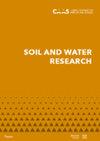Estimation of soil erosion using USLE and GIS in the locality of Tzicatlacoyan, Puebla, México
IF 1.7
4区 农林科学
Q4 SOIL SCIENCE
引用次数: 7
Abstract
Deforestation and conversion of natural grasslands to agricultural land constitute two of the main threats to soil and water conservation, causing erosion, and likely, desertification. The objective of this study was to estimate the erosion of the soil in the locality of Tzicatlacoyan, applying the Universal Soil Loss Equation (USLE) through Geographic Information Systems (GIS). The results indicated that Tzicatlacoyan faces risk of soil erosion with an average annual rate of 117.18 t/ha∙year, due to natural factors and anthropogenic activities such as the use of agricultural land without appropriate conservation practices. Four classes of soil erosion risk were identified, according to the rate of erosion (A) in t/ha∙year: extreme risk (114 ≥ A ≤ 234.36), severe risk (59 ≥ A < 114), moderate risk (23 ≥ A < 59), and low risk (A < 23). Most of the area (180.96 km2, 64.83%) was characterised by the low risk of erosion, while a small part (11.64 km2, 4.17%) of the study area showed extreme risk. The results indicated that 13.33% of the territory of Tzicatlacoyan present values of soil loss exceeding tolerable. The assessment of the soil erosion using the USLE model and GIS might allow land users to make better decisions about the use and conservation of the soil and the ecosystem, adding scientific criteria to their traditional knowledge.基于USLE和GIS的墨西哥普埃布拉州齐卡特拉科扬地区土壤侵蚀估算
砍伐森林和将天然草原转变为农业用地是水土保持面临的两大威胁,造成水土流失,并可能造成荒漠化。本研究的目的是通过地理信息系统(GIS)应用通用土壤流失方程(USLE)来估计齐卡特拉科扬地区的土壤侵蚀。结果表明,由于自然因素和农业用地利用不合理等人为活动,齐恰特拉科扬面临年均117.18 t/ha∙年的土壤侵蚀风险。根据侵蚀速率(t/ha∙年)将土壤侵蚀风险划分为4个等级:极端风险(114≥A≤234.36)、严重风险(59≥A < 114)、中度风险(23≥A < 59)、低风险(A < 23)。研究区大部分面积(180.96 km2, 64.83%)为低风险区,少部分面积(11.64 km2, 4.17%)为极端风险区。结果表明,13.33%的齐卡特拉科岩境内土壤流失量现值超标。利用USLE模型和地理信息系统对土壤侵蚀进行评估,可以使土地使用者对土壤和生态系统的利用和保护做出更好的决策,为他们的传统知识增加科学标准。
本文章由计算机程序翻译,如有差异,请以英文原文为准。
求助全文
约1分钟内获得全文
求助全文
来源期刊

Soil and Water Research
Water resources, Soil Science, Agriculture-WATER RESOURCES
CiteScore
4.60
自引率
0.00%
发文量
26
审稿时长
>12 weeks
期刊介绍:
An international peer-reviewed journal published under the auspices of the Czech Academy of Agricultural Sciences and financed by the Ministry of Agriculture of the Czech Republic. Published since 2006.
Thematic: original papers, short communications and critical reviews from all fields of science and engineering related to soil and water and their interactions in natural and man-modified landscapes, with a particular focus on agricultural land use. The fields encompassed include, but are not limited to, the basic and applied soil science, soil hydrology, irrigation and drainage of lands, hydrology, management and revitalisation of small water streams and small water reservoirs, including fishponds, soil erosion research and control, drought and flood control, wetland restoration and protection, surface and ground water protection in therms of their quantity and quality.
 求助内容:
求助内容: 应助结果提醒方式:
应助结果提醒方式:


